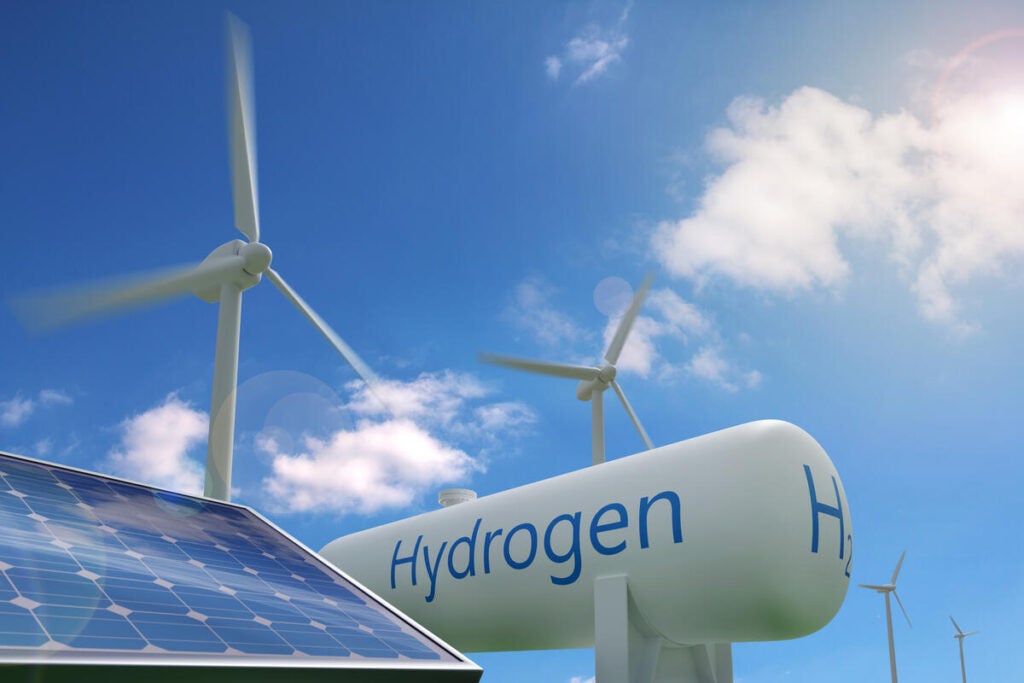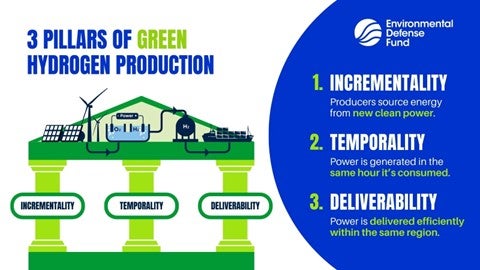What does it mean for hydrogen to be clean? And will the emerging hydrogen economy be able to deliver the meaningful climate benefits it promises? The U.S Treasury is about to make a series of decisions that will determine the answer to these questions for the U.S region, and potentially others around the world who choose to follow by example.
This includes the details of a massive set of tax incentives — the 45V Hydrogen Production Tax Credit, under the Inflation Reduction Act — that will have a major impact on how hydrogen is deployed, scaled, managed and traded for decades to come. A thought out and well implemented set of rules would set a global precedent for how governments can incentivize truly clean hydrogen, while the contrary would create an artificially subsidized market that undercuts the U.S’s climate goals and international competitiveness.
Why a strong ‘3 pillar’ framework makes sense for pivotal hydrogen tax credit Click To TweetBy law, hydrogen producers can earn the production tax credit per kilogram of hydrogen produced over the first ten years of a facility’s hydrogen production, where the size of the credit is based on a sliding scale depending on how clean the hydrogen is estimated to be. As a result, the definition of what constitutes clean and how emissions are estimated is a cornerstone for which hydrogen production pathways will receive a leg-up in the market. Treasury’s final set of guidance will determine the rules.
As with anything in the tax code, there’s a lot of money riding on the fine print, and this has been the source of intense debate. This topic gets technical quickly, but a new report from the world’s largest pureplay sustainability consultancy Environmental Resources Management breaks down the details and offers key insights into how officials can structure this guidance to prevent unintended increases in pollution, while spurring long-term growth in a genuinely clean hydrogen economy.
A focus on green hydrogen and the details that matter
The hydrogen production pathway that will earn the highest credits will be electrolytic hydrogen made by splitting water molecules using electricity — commonly called green hydrogen. So that’s what we are focusing on here. (At the same time, we’re calling for crucial protections for fossil-based hydrogen, which you can read more about here.)
Electrolytic hydrogen, made from clean electricity, has the potential to have the greatest positive impact on the climate and public health, especially when compared to fossil-based hydrogen alternatives. But there is an important caveat. Making hydrogen is an energy-intensive process that requires a lot of electricity — up to 3-7 times as much as using the electricity directly. It matters if the electricity is clean or dirty, and whether it is being used in a way that stimulates greater investment in clean electricity supply or exhausts what is available to use directly for buildings, transportation, and other applications.
Getting this right depends on how we tally the GHG emissions of hydrogen’s electricity supply. To qualify for 45V, most electrolyzers can’t simply pull power from the grid, as the average carbon intensity would be far too dirty. Instead, producers will need to purchase dedicated, truly clean electricity (e.g., through a direct connection, power-purchase agreement or certificates). But the cleanliness of electricity varies by resource, time of day, and other factors like the congestion on neighboring transmission lines and extreme weather events. If these factors aren’t accounted for, an electrolyzer could actually be diverting clean power from other needs and causing the grid to deploy more fossil fuels to meet demand. To be achieved sustainably, hydrogen development needs to not only use clean power, but drive investment in new clean power.
Doing the math
Bringing new clean power on the grid is less like filling a bucket, and more like conducting an orchestra — lots of coordination and fine-tuning has to happen to make it work. And while the details can get complex, the rules needed to ensure hydrogen drives clean power development can be summarized by three simple principles, also known as accounting pillars:
The Biden administration has included these three pillars in its proposed 45V rule, but they nonetheless continue to be a lightning rod for debate. Critics claim the three pillars are difficult to implement and likely to flatten the emerging hydrogen market in its infancy. Yet various analyses from EDF, ERM and others across academia, policy think tanks and industry clearly show that a strong 3-pillar framework is the only way to ensure hydrogen is actually clean — which is the main purpose of the tax credit. For example, studies from Princeton University, Energy Innovation and Evolved Energy Research find that without the 3 pillars, 45V could add hundreds of millions of tons of pollution per year. Industry members representing more than 50 GW of electrolyzer capacity have endorsed the Three Pillars approach as financially viable and implementable.
ERM’s Assessment of Grid-Connected Hydrogen Production Impacts and Implementation Considerations
As Treasury moves into its final rulemaking, EDF wanted to help clarify some of the questions and concerns around the 3-pillar system, and so we asked ERM to dig deeper. We wanted to understand: What does the literature on both sides say about the 3 pillars’ potential effects? How could a 3-pillar system address implementation challenges and ensure the highest-incentivized hydrogen is truly clean? And is the 3-pillar approach actually feasible?
Part one of the report (the literature review) summarizes key findings from about 30 studies, explaining how interpretations can differ based on assumptions and methodologies. Part two assesses the 3 pillars within a regional context, exploring implementation considerations including design options that could address certain stakeholder concerns while maintaining the overall integrity of a strong 3-pillar framework.
The 3 Pillars quite simply add up
The report highlights several findings:
- A 3-pillar framework prevents hydrogen from increasing grid emissions and enables long-term industry growth. Without the 3 pillars, electrolysis will lead to significant net increases in grid emissions, which would make the grid dirtier than it was before. Loose requirements would also place the industry on unstable financial footing and contradict the spirit of the IRA.
- The 3 pillars offer co-benefits for the power and industrial sectors. The 3 pillars will help bolster the domestic market for clean energy technologies, including solutions to complement higher renewable levels (e.g., batteries, transmission lines and grid management systems). In addition, they incentivize the build-out of hydrogen storage and flexible U.S.-made electrolyzer technologies that can be ramped up and down depending on hourly needs.
- Incrementality will have an outsized effect on grid decarbonization. Without strong requirements, the grid will respond to increased power demand from electrolyzers by ramping up fossil fuel generation for other customers. ERM finds that studies agree that incrementality requirements are essential to avoiding this type of net emissions increase. In this report, incrementality is defined as new clean power, or clean power that would otherwise not have existed but was enabled by hydrogen demand. This could include nuclear capacity under threat of retirement, curtailed generation and capacity expansions (e.g., through uprates and repowering) — all of which can help maximize power grid performance.
- Temporality limits emissions without increasing production costs. Hourly matching drives better alignment of clean supply and demand and avoids significant emissions increases on the grid. Advanced grid modeling reviewed by ERM suggests hourly matching would only negligibly affect production costs (adding 10-20 cents per kilogram) and could in some instances avoid significant increases in customer electricity prices.
- Deliverability helps build regional networks that connect over time. The deliverability pillar ensures electricity supply and hydrogen production demand are physically connected via the grid, leveraging local resources to establish regional networks. While today that may translate into the DOE’s Transmission Needs Study boundaries or EPA’s set of eGRID regions, those may change over time as transmission build-out occurs. In the meantime, there may be some ability to allow cross-regional transmission where producers can demonstrate a lack of constraints.
- The 3 pillars allow some flexibility while retaining emissions integrity. This framework can be enhanced by considering special cases, which may satisfy regional needs while maintaining a strong emissions backstop. For example, the EU’s 3-pillar system makes exceptions for curtailed resources and highly clean local grids (e.g., for grids with 90%+ renewables). The U.S. could consider similar provisions where grids are at lower risk for increasing emissions from marginal resources, such as areas with very high renewable penetration rates (90-95%), very low carbon intensities or high-integrity emissions caps.
- Short-term challenges bring long-term opportunities. Building up accounting systems takes time and resources; fortunately, many of the building blocks for this type of accounting system are already built into existing certificate tracking systems, renewable portfolio standards and elements driven by the voluntary corporate space. And where they need to be built out further, those capabilities will be useful well beyond 45V. For example, technical issues like the use of hourly certificates, eliminating double counting and expanding customers’ options for renewable energy supplies will be important down the line as our grid becomes more decarbonized.
- The 3 pillars are a path forward for a durable, long-lasting framework. A flexible but strong 3-pillar framework sets up a sustainable hydrogen economy from the start, enabling the industry to trade with market partners and sustain itself in a post-PTC world.
This is the moment that will decide whether taxpayer dollars are put towards incentivizing hydrogen that is truly clean, and that will shape the industry for decades to come. It will also serve as a critical precedent for future tax credits, policies and regulations around emissions accounting — both for hydrogen and beyond. Treasury must finalize a strong 3 pillar framework to ensure our largest public incentive for this promising decarbonizing technology delivers on its promise.
To learn more, read the full report or get a quick overview from the fact sheet.

